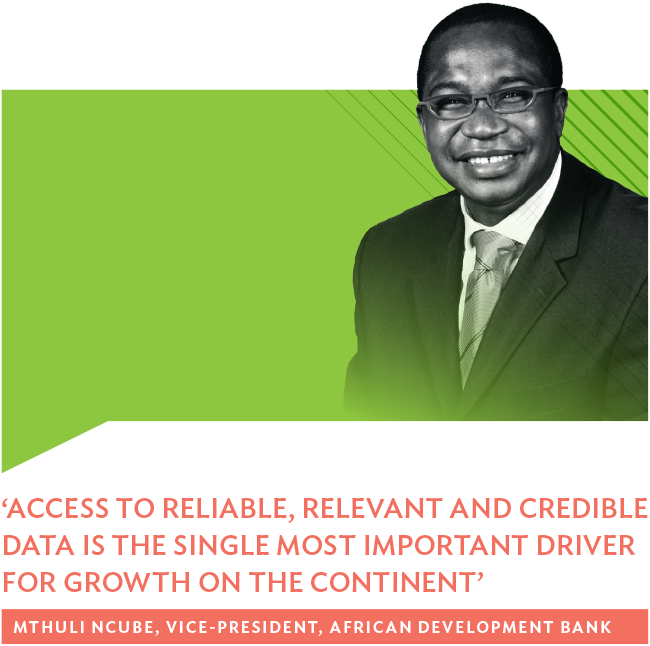More data than ever before is now available, collected by traditional means, as well as new ways made possible by technology. Crowdsourcing, mobile telephones, satellites, and data-capturing using scanning devices, are all changing the data landscape. Good data is critical for investors wanting to find worthwhile opportunities in the often misunderstood and unknown continent. It also helps steer them away from the risks to make better investment and strategic decisions.
‘Access to reliable, relevant and credible data is the single most important driver for growth on the continent,’ says African Development Bank (AfDB) chief economist and vice-president Mthuli Ncube. ‘It enables governments, business leaders, investors and the ordinary African citizen to not only make informed decisions but, for the first time, to also properly manage and monitor development outcomes.’
In 2016, Africa was the second-fastest growing destination in terms of attracting foreign direct investment capital, according to EY’s latest Africa Attractiveness report. As the continent seeks to attract investment in order to develop, the quality of its data matters.
Work by the AfDB and the Africa Securities Exchange Association (ASEA) in improving statistical frameworks and access to market data has led to significant progress in data collection and analysis.
In his 2015 book, the Emerging Data Revolution in Africa: Strengthening the Statistics, Policy and Decision-making Chain, Ben Kiregyera writes that the previous 10 years have seen a ‘galvanisation of pan-African, regional and national organisations and the statistical community in Africa generally to address data challenges and to create “virtuous” statistical systems’. He argues that data has improved in scope, quantity and quality, while more resources – although not enough – have been made available to build statistical capacity and infrastructure in Africa.
The 2016 African Data Revolution Report finds there is increased availability of both new types of data and traditional data in Africa, while data-related rights have been introduced. According to the report, ‘underlying the concept of the African data revolution is a fundamental conceptual and paradigmatic shift on the question of who and what officially counts, is counted, how, by whom, for whom and for what purposes’.
Historically, there has been a lack of useful economic and demographic data in Africa, and most other emerging and frontier markets. This is partly due to inadequate funding, little checking for accuracy, and few incentives to improve, according to the Data for African Development working group.
Improving data quality can dramatically change an investor’s view of a country. Nigeria became Africa’s biggest economy overnight – increasing by a hefty 89% – after rebasing its numbers in 2014 (although SA has since overtaken it). Ghana rebased its GDP figures in 2010 when its economy was found to be 63% larger than previously determined.
Misleading data can also alter investor perceptions. The AfDB in 2011 classified around a third of Africans, or 350 million people, as middle class. This was an increase from 126 million in 1980. However, Standard Bank in 2014 saw it differently, arguing just 15 million households could qualify as middle class. The AfDB determined middle class as people living on $2 to $20 a day. Standard Bank used the scientific methodology of SA’s Living Standards Measure to find that the middle class grew by 230% to 15 million in 2014 from 4.6 million in 2000.
While both the AfDB and Standard Bank predicted the middle class was growing, and would continue to grow significantly, the difference in their estimates could have significant implications for investors. Take for example, an investor in retail stocks who would rely on information about the size of the middle class to inform his investment decision.
The amount of data in the world is more than doubling every year, according to the Africa Data Revolution Report 2016. Big data, which includes the vast sum of digital data produced through communication on mobile devices, social media, internet searches, satellite imagery and telecoms data is providing us with new insights and ways of looking at the world.
Many African countries have implemented reforms and programmes to harness both traditional and big data. However, more needs to be done. ‘The right legal, legislative and policy environments will create conditions that are conducive to harnessing the data revolution for sustainable development in Africa,’ according to the Africa Data Revolution Report.
The AfDB has been focusing on improving the availability and quality of data and on streng-thening the institutional capacity of African countries to help them produce useful data. Although it is motivated by the need to meet developmental objectives, the data is equally useful to investors.
The AfDB introduced the Africa Information Highway (AIH) programme in 2011 to build statistical capacity in Africa. Described as a ‘mega network’ of live open data platforms that link all African countries and 16 regional organisations, the programme aims to increase public access to statistics across the continent. It also supports countries to improve data quality, management and dissemination through funding and training.
‘The ultimate aim of AIH is to scale up Africa’s participation in the global economy and improve its competitiveness, as well as boosting social advancement,’ says the AfDB.
The system includes topic-specific data portals including energy, infrastructure, climate change and health. Users can also access data on an array of topics such as financial flows, Ebola and food prices. The idea is to provide a one-stop shop for capturing and sharing African developmental data.
The programme was recognised as one of the most innovative data initiatives globally by the Partnership in Statistics for Development in the 21st Century at the Organisation for Economic Co-operation and Development in 2015. This was due to the programme being an enabler of the data revolution, and for providing ‘the right data, to the right people, at the right time, in the right format’.
The AfDB’s launch of open data platforms across Africa gives users access to a vast array of development data from multiple international and national sources. The data is reliable and timely and information can be exchanged across the common IT platforms, allowing policy-makers, investors and researchers to make better decisions.
The private sector, from banks and miners to construction companies, also produces vast amounts of data on Africa, much of it for internal use or only for paying users. But some private-sector players have historically made financial data available, including national stock or securities exchanges such as Côte d’Ivoire, Egypt, Kenya, Morocco, Namibia, Nigeria, SA and Zimbabwe.
‘With the rise of big and open data, and the growth in the ICT sector, the private sector is increasingly becoming a critical and dynamic player within African data ecosystems,’ according to the Africa Data Revolution Report 2016. ‘Typically, these companies have sophisticated information systems and data-mining and analytical capabilities, and collect enormous amounts of data.’ As such, most African countries have laws allowing for the private sector to participate in their statistical systems, subject to certain checks and balances.
One of ASEA’s goals is to improve data availability on African exchanges. It has partnered with the AfDB on the African Financial Markets Initiative to develop local currency bond markets on the continent. Improving the availability and transparency of African fixed income data is one of its primary objectives. The database covers bond and bill issues for 45 African countries from 2000 (to the extent that the data is available), which it collects from central banks and finance ministries, as well as from stock exchanges and financial market associations.
The initiative is working to create a comprehensive database providing updated information on African local currency bond markets. The aim of the database is to reconcile and standardise data produced by various institutions across the continent, as well as to improve the quality of financial statistics.
While the Africa Data Revolution Report 2016 finds that the building blocks for an effective data ecosystem already exist in Africa, it points out there are still ‘significant deficits, gaps and weaknesses’. The report calls for the ‘right legal, legislative and policy environments that will create conditions that are conducive to harnessing the data revolution for sustainable development in Africa’. It also calls for significant investment in data technologies, platforms and tools.
‘African exchanges’ data infrastructure is certainly modernising,’ says Oliver Hoffmann, investor relations consultant at Sharenet.
‘Overall, general investor relations practices have made much progress in the past 10 years and basic trade data has been available via exchange websites and data vendors for some time. However, where African exchanges, apart from the JSE, remain deficient is in the provision of more granular issuer and index data required for fundamental analysis. For the time being though, the lowest hanging fruit would be the provision of electronic news services akin to the JSE’s SENS.’
The continent is definitely moving in the right direction. As Kiregyera wrote, ‘much progress is being made’ and initiatives such as the AfDB’s work on improving statistical frameworks ‘will hold the continent in good stead in years to come’ – although it required increased attention and support.










